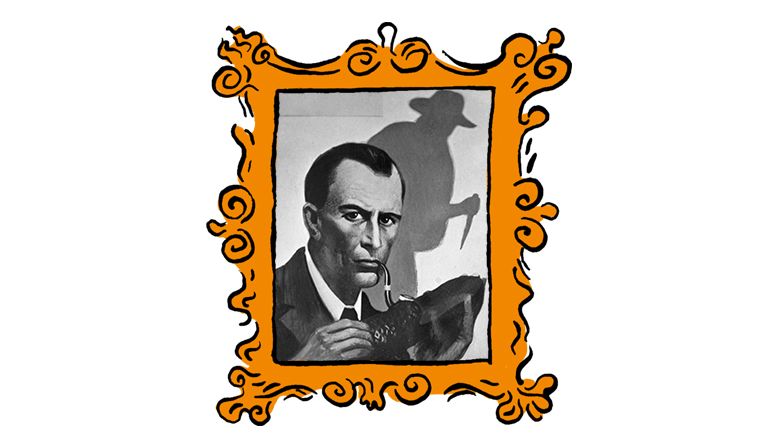Before modern jazz claimed my soul around the age of 14, matters Sherlockian were my primary concern. I read nothing but Sherlock Holmes for two years, the official Conan Doyle canon and also some very non-official titles: Holmes goes to Vienna to consult with Sigmund Freud; Holmes as a futuristic time-traveller, which would explain his taste for avant-garde violin music. Basil Rathbone and Jeremy Brett were my heroes before Duke Ellington and Thelonious Monk. I managed to trace Holmes on screen back as far as Arthur Wontner, who played the character between 1931 and 1937—but the actor who portrayed Holmes a decade earlier, Eille Norwood, proved stubbornly elusive.
It didn’t help that the Sherlock Holmes handbook my parents gave me for Christmas misspelt his name—“Ellie” Norwood—which, demonstrating the limits of my own powers of deduction, threw me off the scent. The bigger problem, though, was that the series of 47 Holmes films made between 1921 and 1923 by Cricklewood-based Stoll Pictures, starring Norwood, had, beyond a few stills, crumbled apparently beyond repair. To date, Norwood remains the most prolific Holmes on the cinema screen and the films were, at the time of their making, a big deal. As he was preparing to get inside the character, Norwood consulted Conan Doyle, who was said to have been entranced by what he saw. So when the barely believable news dropped that restorations of three Norwood/Holmes films were to be screened as part of this year’s BFI London Film Festival, I knew I had to make the pilgrimage.
“A Scandal In Bohemia”, “The Golden Pince-Nez” and “The Final Problem”—presented under the title Silent Sherlock—were screened last week at the Alexandra Palace Theatre, accompanied by freshly composed scores performed by an ensemble of ten musicians studying at the Royal Academy of Music who were conducted from the piano by Joanna MacGregor. Screening these restored films in a partly restored Victorian theatre—suspended in what is described as a “state of arrested decay”—rather than the BFI’s regular space on the South Bank was an inspired choice. Although there’s no direct evidence that Conan Doyle or Norwood ever visited the theatre, the space felt as though it was summoning up their ghosts anyway.
When Norwood’s face appeared for the first time onscreen—and in close-up—I gasped. Here, at last, was the encounter I’d been coveting for almost 40 years, and the questioning intensity of his eyes, second only to Jack Nicholson’s in The Shining, seemed to be asking where I’d been all these years. Those eyes revealed the soul of a man with acute intelligence and rare insight—within a few seconds of his appearance, Eille Norwood was Sherlock Holmes.
By the time Benedict Cumberbatch took the role in 2010 for the BBC’s Sherlock, a century’s worth of Sherlockian mythology was there to be distilled and played with. But the Norwood films appeared before any Holmesian cinematic mythology had become set in stone. Holmes’s rooms at 221b Baker Street were shown with the expected array of pipes, a violin and plush velvet smoking chairs. The deerstalker and curved pipe motif, never part of the original Conan Doyle vision, were nowhere to be seen, and Norwood’s Holmes defaulted to a porkpie hat. His Dr Watson, played by Hubert Willis, hinted at the aimable buffoon that Nigel Bruce would portray in the Rathbone films a decade later. In the original stories he’s a more thoughtful and sensitive figure, but perhaps the straight man playing to a comic foil works better cinematically.
Norwood playing Holmes so convincingly, without any of the familiar mythological props, made me realise how intricately Conan Doyle’s prose carried both the character of Holmes and the complexity of the settings in which he was placed. That catchphrase—“Elementary, my dear Watson”—which famously never appeared in any original Holmes story, became an idée fixe of the Rathbone films. When Norwood proclaims instead that “It’s simple Watson, I’m sure you’ll understand,” that was their solution, framed inside a nifty soundbite, to encapsulating the rich and mysterious relationship between Holmes and Watson, which, on the page, had scope to be mapped out in greater detail.
I say “framed” advisedly. A peculiarity of the Norwood films is, of course, that there is no spoken dialogue. Even as someone deeply versed in Charlie Chaplin, Harold Lloyd and Buster Keaton, adapting to silent Sherlock—Holmes stripped of the fruity Victoriana splendour of Conan Doyle’s prose—took some time. Lips quiver furiously onscreen, imparting details clearly of great import; then, after longer than seems decent, a deflatingly simple caption card like: “We had better let him in, Watson.” But adapt I did. The calculation, back in the 1920s, was that the tics of the character were embedded so deeply inside the popular psyche that information could be relayed in shorthand. A 100 years on, I found that was still a winning strategy.
The stories, too, needed adapting. “The Final Problem” ended with the cliffhanger of Holmes fighting archenemy Professor Moriarty not, as per Conan Doyle, at the Reichenbach Falls in Switzerland—but at Cheddar Gorge in Somerset, easier no doubt to reach with a 1920s film crew, but no less terrifying.
“A Scandal In Bohemia”, the Conan Doyle original used here more as a starting point than faithfully, hit its melodramatic climax outside the stage door of the Ambassadors Theatre, off Charing Cross Road. I’ve just been to look at the same spot and it has barely changed in a century, which seems like a fitting metaphor for Holmes himself. Fresh generations of actors and directors might push the stories in a thousand different directions—but the fundamental notes and harmonies set by Conan Doyle are reassuringly immovable.
Sherlock Holmes is eternal
New restorations of near-lost films from the 1920s show just how unchanging this extraordinary character has been
October 24, 2024

© colaimages / Alamy









